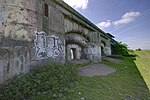Cliffe Fort

Cliffe Fort is a disused artillery fort built in the 1860s to guard the entrance to the Thames from seaborne attack. Constructed during a period of tension with France, it stands on the south bank of the river at the entrance to Cliffe Creek in the Cliffe marshes on the Hoo Peninsula in North Kent, England. Its location on marshy ground caused problems from the start and necessitated changes to its design after the structure begin to crack and subside during construction. The fort was equipped with a variety of large-calibre artillery guns which were intended to support two other nearby Thamesside forts. A launcher for the Brennan torpedo—which has been described as the world's first practical guided missile—was installed there at the end of the 19th century but was only in active use for a few years. Cliffe Fort saw about 60 years of usage as an artillery fort, from its completion in 1870 to its disarmament in 1927. It was repurposed during World War II to serve as an anti-aircraft battery on the approaches to London. The fort's military career ended when it was sold off after the war to the owners of a neighbouring aggregates works. Today it lies derelict, overgrown and heavily flooded. It is not accessible to the public and is in a poor and slowly deteriorating condition which has led it to be listed as an "at risk" heritage asset.
Excerpt from the Wikipedia article Cliffe Fort (License: CC BY-SA 3.0, Authors, Images).Cliffe Fort
Salt Lane,
Geographical coordinates (GPS) Address External links Nearby Places Show on map
Geographical coordinates (GPS)
| Latitude | Longitude |
|---|---|
| N 51.463608 ° | E 0.455871 ° |
Address
Cliffe Fort
Salt Lane
ME3 7SU , Cliffe and Cliffe Woods
England, United Kingdom
Open on Google Maps










